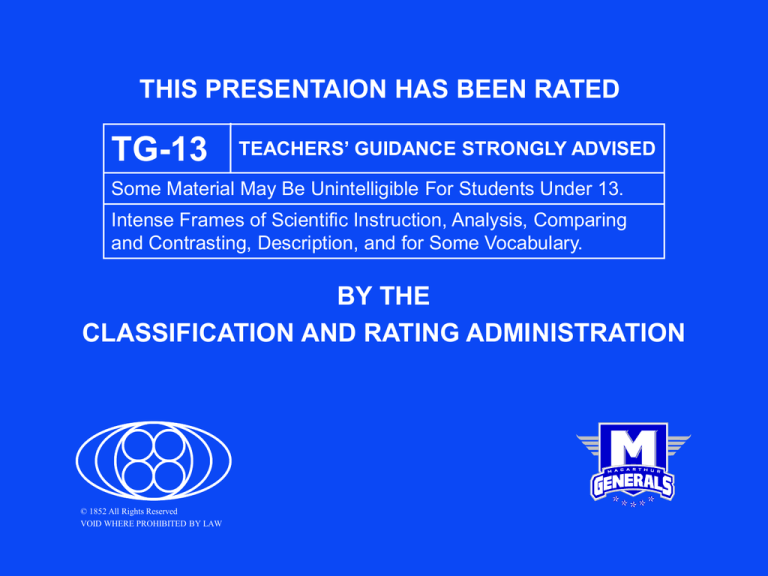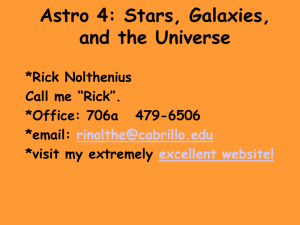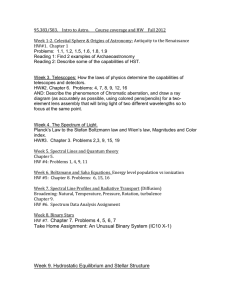
THIS PRESENTAION HAS BEEN RATED
TG-13
TEACHERS’ GUIDANCE STRONGLY ADVISED
Some Material May Be Unintelligible For Students Under 13.
Intense Frames of Scientific Instruction, Analysis, Comparing
and Contrasting, Description, and for Some Vocabulary.
BY THE
CLASSIFICATION AND RATING ADMINISTRATION
© 1852 All Rights Reserved
VOID WHERE PROHIBITED BY LAW
PBIS ANTI-VACUITY
The authorized reproduction or distribution of
this copyrighted work is highly encouraged.
Lethargic obtuseness is insubordinate and is
discouraged by PBIS, as it may result in little
or no monetary gain after secondary
education or a fine of $250,000.
© 1852 All Rights Reserved
VOID WHERE PROHIBITED BY LAW
ASTRONOMY
Stars
OBJECTIVES
By the end of this presentation, students will
be able to
• describe six properties of stars that can be
determined from the earth;
• Explain some of the difficulties astronomers
have in measuring these properties.
STELLAR PROPERTIES
1. Distance - using parallax
Astronomers photograph the
Earth orbiting
the sun.
star against
a different set
of background stars.
Astronomers
photograph a star against
Earth
six months
later.
a
background
of stars.
STELLAR PROPERTIES
1. Distance - using parallax
The apparent shift in
position of the star is
the parallax angle.
a
D
STELLAR PROPERTIES
1. Distance - using parallax
Knowing this angle and
using simple trigonometry,
the distance D can be
calculated.
a
D
STELLAR PROPERTIES
1. Distance - using parallax
The parallax angle
measures the stellar
distance in parsecs.
a
D
STELLAR PROPERTIES
1. Distance - using parallax
This is converted into more
familiar units - the mile and
the light-year.
a
D
STELLAR PROPERTIES
1. Distance - using parallax
The nearest star to the sun
is 4.3 ly away, or
25,284,000,000,000 miles.
a
D
STELLAR PROPERTIES
1. Distance - using parallax
There are 2000+ stars
within 20 parsecs, or 65 ly,
of the earth.
a
D
STELLAR PROPERTIES
1. Distance - using Cepheid variable
stars, et al.
Cepheid variable stars brighten and
dim at regular intervals, due to a
regular swelling and shrinking of the
star.
The brighter the star, the longer the
period of brightening and dimming.
STELLAR PROPERTIES
ABSOLUTE MAGNITUDE
1. Distance - using Cepheid variable
stars, et al.
-6
-5
-4
-3
-2
-1
0
RR LYRAE
0.1 0.2 0.3 0.5 1.0 2
3
5
10 20 30 50 100
PERIOD (days)
STELLAR PROPERTIES
1. Distance - using Cepheid variable
stars, et al.
Periods of Cepheid variables vary from
7 hours to 100 days.
Knowing their absolute brightness and
comparing this to their apparent
brightness, the distance to the star
may be calculated.
STELLAR PROPERTIES
1. Distance - using Cepheid variable
stars, et al.
Ap.Mag - Abs. Mag. = 5 x log(dist÷10)
Technique has an error margin of at
least 10%.
Problem: to calculate distances to
other stars, their brightness must be
known, but to determine their
brightness, their distances must be
known!!
STELLAR PROPERTIES
1. Distance - using red shift in galaxies
The Doppler Effect is used to
determine the speed of approach or
recession of stars and galaxies
based on the shifts in characteristic
frequencies of the light they emit.
STELLAR PROPERTIES
1. Distance - using red shift in galaxies
Blue Shifting - a shift in the emission
spectra of a star towards more
energetic values
• Indicates the star is moving
towards the observer.
• The greater the blue shift, the
faster the star is moving.
STELLAR PROPERTIES
1. Distance - using red shift in galaxies
Red Shifting - a shift in the emission
spectra of a star towards less
energetic values
• Indicates the star is moving away
from the observer.
• The greater the red shift, the
faster the star is moving.
STELLAR PROPERTIES
1. Distance - using red shift in galaxies
The shifted frequencies, (fs) are
compared to the “at rest” (fo) and the
speed of the star can be calculated:
v = (fo2 - fs2) c
(fo2 + fs2)
STELLAR PROPERTIES
1. Distance - using red shift in galaxies
Problem : the red shift might be due to
the recession of the galaxy or due to
other influencing effects… which?
STELLAR PROPERTIES
2. Luminosity –
- the
the total
total amount
amount of
of
energy a star radiates each second.
Apparent Magnitude – the brightness
of a star as viewed by an observer
on the earth.
• determined by comparing the
brightness of various stars on
photographs.
STELLAR PROPERTIES
2. Luminosity – the total amount of
energy a star radiates each second.
The first brightest stars have a
magnitude of +1.
The next brightest stars have
magnitudes of +2
Each magnitude of brightness is 2.5
times brighter (or dimmer) than the
one before it.
STELLAR PROPERTIES
2. Luminosity – the total amount of
energy a star radiates each second.
Stars of a magnitude greater than +6.0
are too dim to be seen without
optical aide.
Stars of a magnitude greater than +9.0
are too dim to be seen using small
telescopes or binoculars.
The sun has a magnitude of – 26.
STELLAR PROPERTIES
2. Luminosity – the total amount of
energy a star radiates each second.
Once the absolute magnitude has
been determined, the luminosity can
be calculated and compared to the
luminosity of our sun.
Abs. Mago – Abs. Mag.s = 2.5 log Ls
Lo
Luminosity of the sun is 4x10
1 = 26
Lowatts.
STELLAR PROPERTIES
2. Luminosity – the total amount of
energy a star radiates each second.
Luminosity of all visible stars range
from 1/1,000,000 the luminosity of
the sun to 1,000,000 time the
luminosity of the sun.
90% of the stars are not as bright as
the sun.
STELLAR PROPERTIES
3. Stellar Temperatures - using color
from spectrographs and Wien’s Law.
Wien’s Law - the wavelength of the
most intense light emitted from a star
is proportional to the star’s
temperature.
(the hotter the star, the bluer it looks.)
Temperature = 345 x (wavelength)
STELLAR PROPERTIES
3. Stellar Temperatures - using color
from spectrographs and Wien’s Law.
The range of temperatures for
observable stars are from 1/3 as hot
as our sun to 10 time as hot as our
sun
The sun’s surface temperature is
5500ºC or 9900ºF
STELLAR PROPERTIES
4. Stellar Diameter – using
Luminosities, temperature and ...
Stephan-Boltzman Law
Ls = 7.2x10-7 R2 T4
Stars range in size from 1/100 the size
of the sun to 100 times the size of
the sun.
STELLAR PROPERTIES
5. Stellar Composition - using spectral
examinations.
Detecting two or more lines of that
element in the star’s spectrum
indicates that element is present in
that star.
The brighter the spectral line, the
greater amount of that element in the
star.
STELLAR PROPERTIES
5. Stellar Composition - using spectral
examinations.
Hydrogen
Helium
Iron
Calcium
White light
STELLAR PROPERTIES
5. Stellar Composition - using spectral
examinations.
Most stars (98%)
are made of
hydrogen and helium.
1 or 2% of the star’s mass may
contain iron, titanium, calcium,
sodium ...
STELLAR PROPERTIES
6. Stellar Mass - using direct
observations through telescopes...
This works only with visual binary
stars, because the period of each
star orbiting the other and the
distances between each star must be
known.
STELLAR PROPERTIES
6. Stellar Mass - using direct
observations through telescopes...
In combining Kepler’s Law of Harmony
with Newton’s Law of Gravity:
G T2 = M1 + M2
4p2 R3
And
M1 = D12
M2 = D22
The masses can be calculated.
STELLAR PROPERTIES
6. Stellar Mass - using direct
observations through telescopes...
Stellar masses range from 0.5 to 50
times the mass of the sun.
This technique works ONLY with
multiple star systems; binaries,
trinaries, etc…
H-R DIAGRAM
A pattern of groups of stars emerge
when plotting the Abs. Mag. of a star
as a function of its temperature.
ABSOLUTE MAGNITUDE
Wolf-Rayet
-10
Stars-5
Hypergiants
Super Giants
Red Giants
0
+5
+10
+15
+20
White Dwarfs
30K
10K
7.5K
Red Dwarfs
6K
5K
TEMPERATURE (ºK)
3K
ABSOLUTE MAGNITUDE
RUSSELL-VOGT
THEOREM – the
H-R DIAGRAM
equilibrium
an ordinary
A
pattern of structure
groups ofofstars
emerge
star
is determined
byofitsa star
when
plotting the uniquely
Abs. Mag.
mass
chemical
as a and
function
of its composition.
temperature.
-10
-5
0
+5
+10
+15
+20
30K
10K
7.5K
6K
5K
TEMPERATURE (ºK)
3K
ASTRONOMY
Stars








